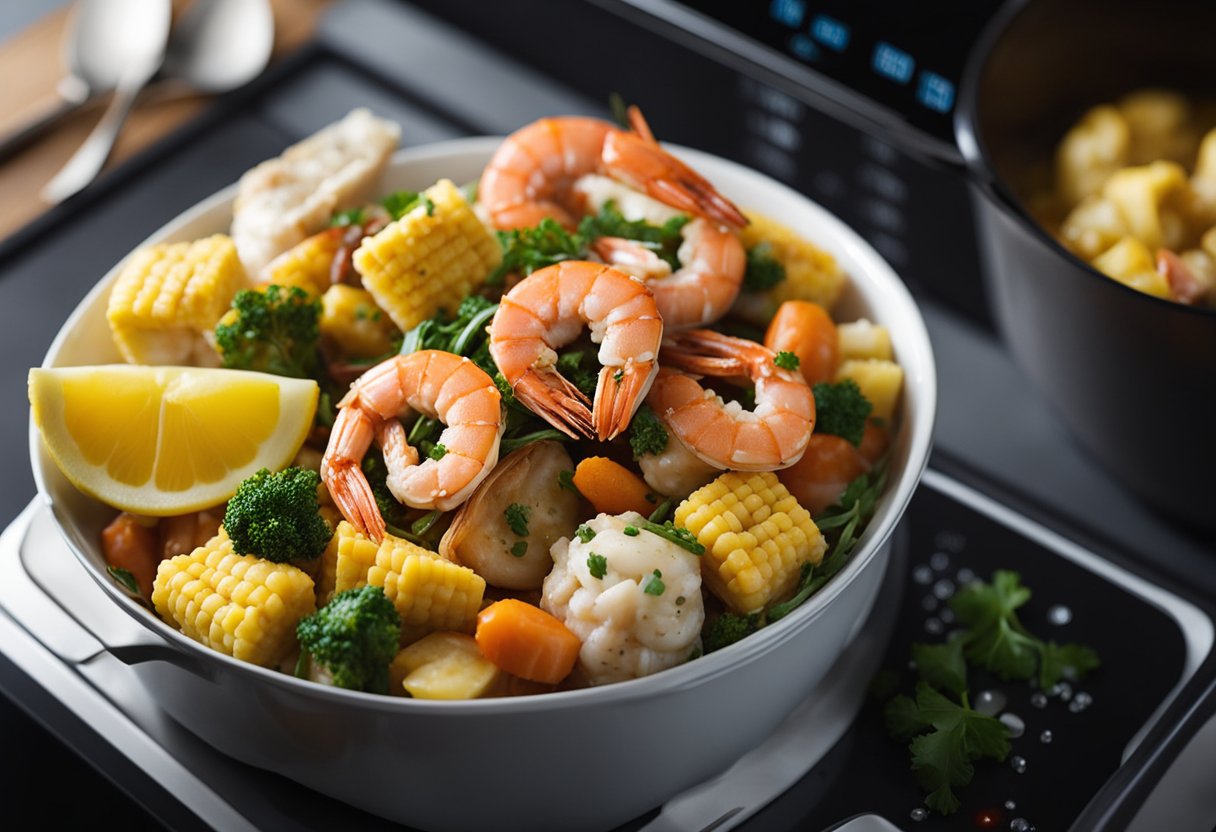As a seafood lover, I always make sure to store my cooked shrimp properly to avoid any health risks. Cooked shrimp is a perishable food that requires safe handling and storage to prevent bacterial growth and spoilage.
The question of how long cooked shrimp can stay out is crucial to avoid food poisoning and ensure the quality of the dish.
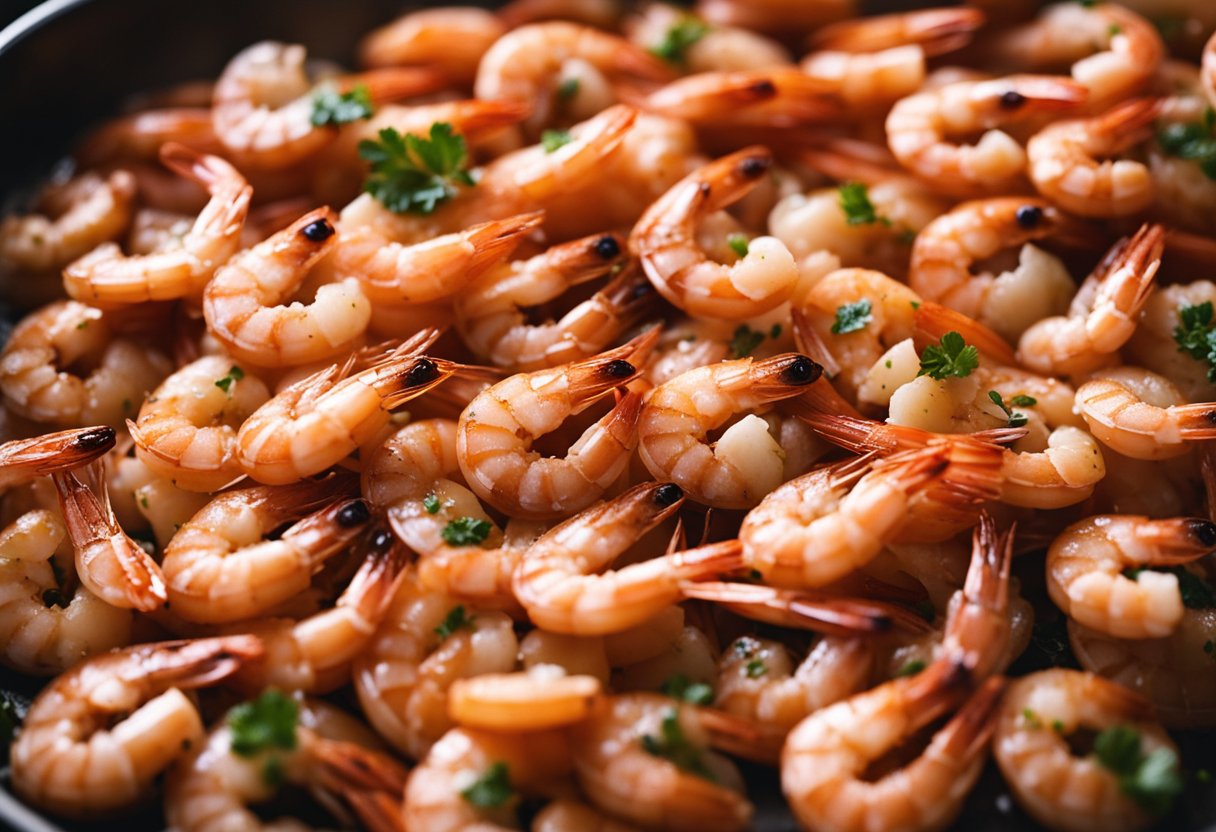
According to my research, cooked shrimp shouldn’t be left out at room temperature for more than two hours, less if the temperatures are above 90 degrees Fahrenheit.
After this time, the bacterial growth will have started to destroy the shrimp, making it unsafe to eat. It’s essential to understand the role of temperature in shrimp storage to avoid any health risks.
Key Takeaways
- Cooked shrimp should not be left out at room temperature for more than two hours to prevent bacterial growth and spoilage.
- Proper handling and storage of cooked shrimp are crucial to ensure its quality and prevent food poisoning.
- Reheating leftover shrimp at a low temperature is the best practice to avoid the rubbery texture that shrimp can get when overcooked.
Understanding Shrimp as a Perishable Food
As a seafood, shrimp is a perishable food that needs to be handled with care to prevent spoilage and foodborne illness. Shrimp, like all seafood, is highly perishable and can spoil quickly if not stored properly.
Perishable foods are those that can spoil or become unsafe to eat if they are not stored or handled properly. Seafood and shellfish are especially perishable because they are high in protein, which provides an ideal environment for bacteria to grow.
Shrimp is particularly susceptible to spoilage because it is a small, delicate shellfish that is often sold cooked or partially cooked.
Cooked shrimp can be left out at room temperature for up to two hours before it becomes unsafe to eat. After that time, bacteria can start to grow on the food, which can cause food poisoning.
To prevent spoilage, it is important to store shrimp properly. Cooked shrimp should be stored in the refrigerator at a temperature of 40°F or below. It is also important to keep shrimp away from other foods that could contaminate it with bacteria.
In summary, shrimp is a highly perishable food that needs to be handled with care to prevent spoilage and foodborne illness. Cooked shrimp can be left out at room temperature for up to two hours before it becomes unsafe to eat.
To prevent spoilage, cooked shrimp should be stored in the refrigerator at a temperature of 40°F or below.
Safe Handling and Storing of Cooked Shrimp
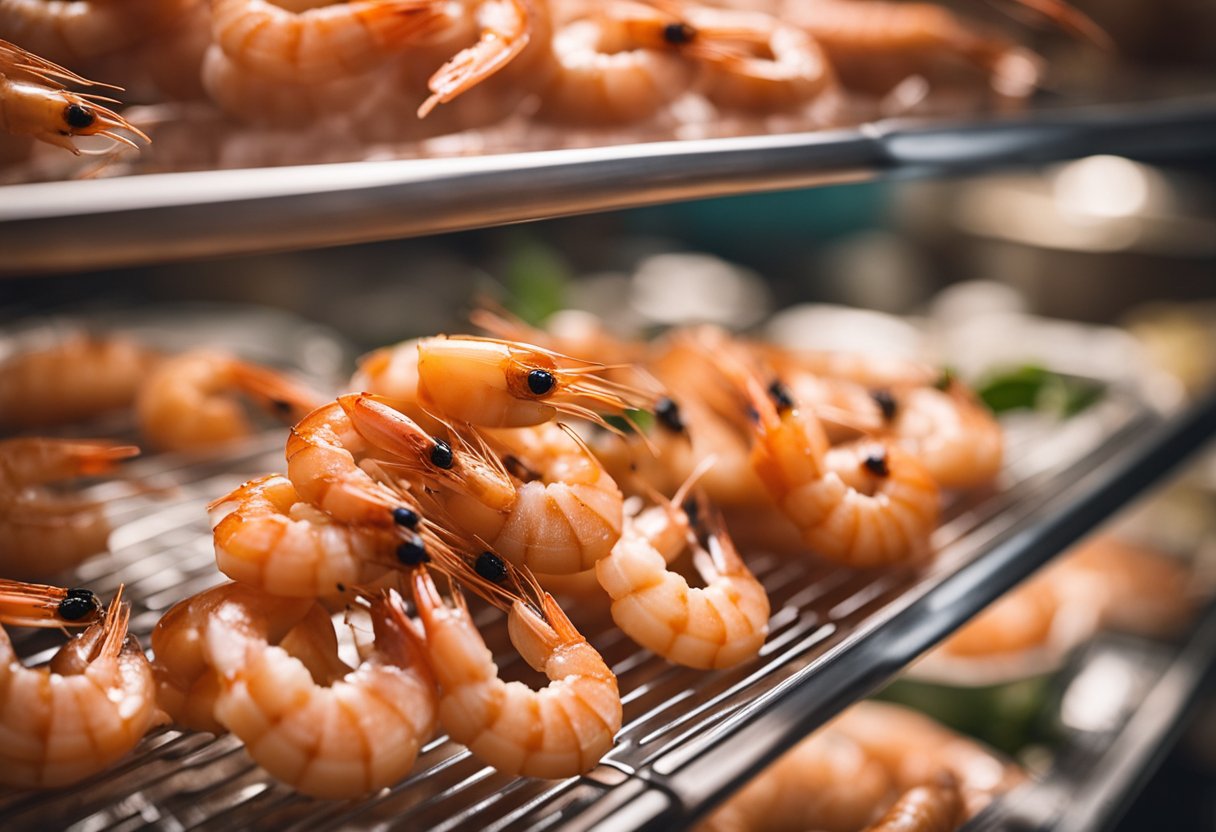
As a chef, I know how important it is to handle and store cooked shrimp properly to ensure food safety.
Here are some tips to help you store cooked shrimp safely:
- Refrigerate cooked shrimp within two hours of cooking it. This will help prevent the growth of harmful bacteria that can cause foodborne illness.
- Store cooked shrimp in an airtight container in the refrigerator. This will help keep it fresh for up to four days. You can also store the shrimp in a plastic bag, but make sure it is airtight.
- If you want to freeze cooked shrimp, place it in a freezer-safe bag and label it with the date. Cooked shrimp can be stored in the freezer for up to three months.
- When storing cooked shrimp, make sure to keep it separate from raw shrimp to prevent cross-contamination.
- Always wash your hands before handling cooked shrimp to prevent the spread of bacteria.
Remember that cooked shrimp can only be stored for a limited time, so it is important to use it before it goes bad. If the shrimp has an off smell or slimy texture, it is best to discard it.
By following these simple tips, you can ensure that your cooked shrimp stays fresh and safe to eat.
The Role of Temperature in Shrimp Storage
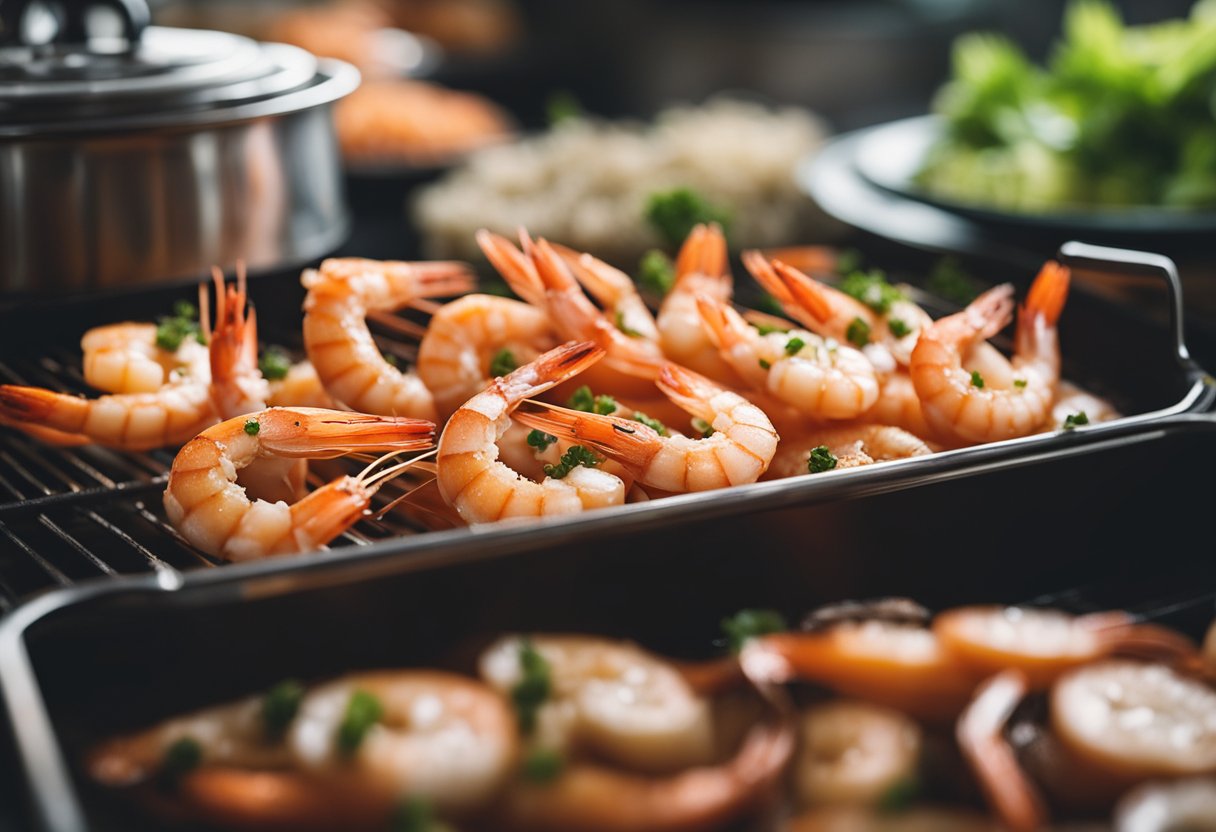
As a cook, I know that temperature plays a crucial role in the storage of any food item. The same is true for cooked shrimp. Once cooked, shrimp should be stored at the right temperature to ensure that it remains safe for consumption.
When it comes to cooked shrimp, the temperature should be maintained at or below 40°F (4°C). This means that if you are not planning to consume the shrimp immediately, it should be stored in the refrigerator.
Leaving cooked shrimp out at room temperature for too long can lead to bacterial growth and foodborne illnesses.
According to the United States Department of Agriculture (USDA), cooked shrimp should be refrigerated within 2 hours of cooking. It is recommended to consume refrigerated cooked shrimp within 3 to 4 days for optimal quality and safety.
If you are not planning to consume the cooked shrimp within this time frame, it should be stored in the freezer.
If you need to thaw frozen cooked shrimp, it is best to do so in the refrigerator. Alternatively, you can place the frozen shrimp in a sealed plastic bag and submerge it in cold water.
However, make sure to change the water every 30 minutes to ensure that the shrimp remains at a safe temperature.
In summary, the temperature at which cooked shrimp is stored is crucial in ensuring its safety for consumption. Cooked shrimp should be stored in the refrigerator at or below 40°F (4°C) and consumed within 3 to 4 days.
If you are not planning to consume the shrimp within this time frame, it should be stored in the freezer. If you need to thaw frozen cooked shrimp, do so in the refrigerator or by submerging it in cold water and changing the water every 30 minutes.
The Process of Freezing and Thawing Shrimp
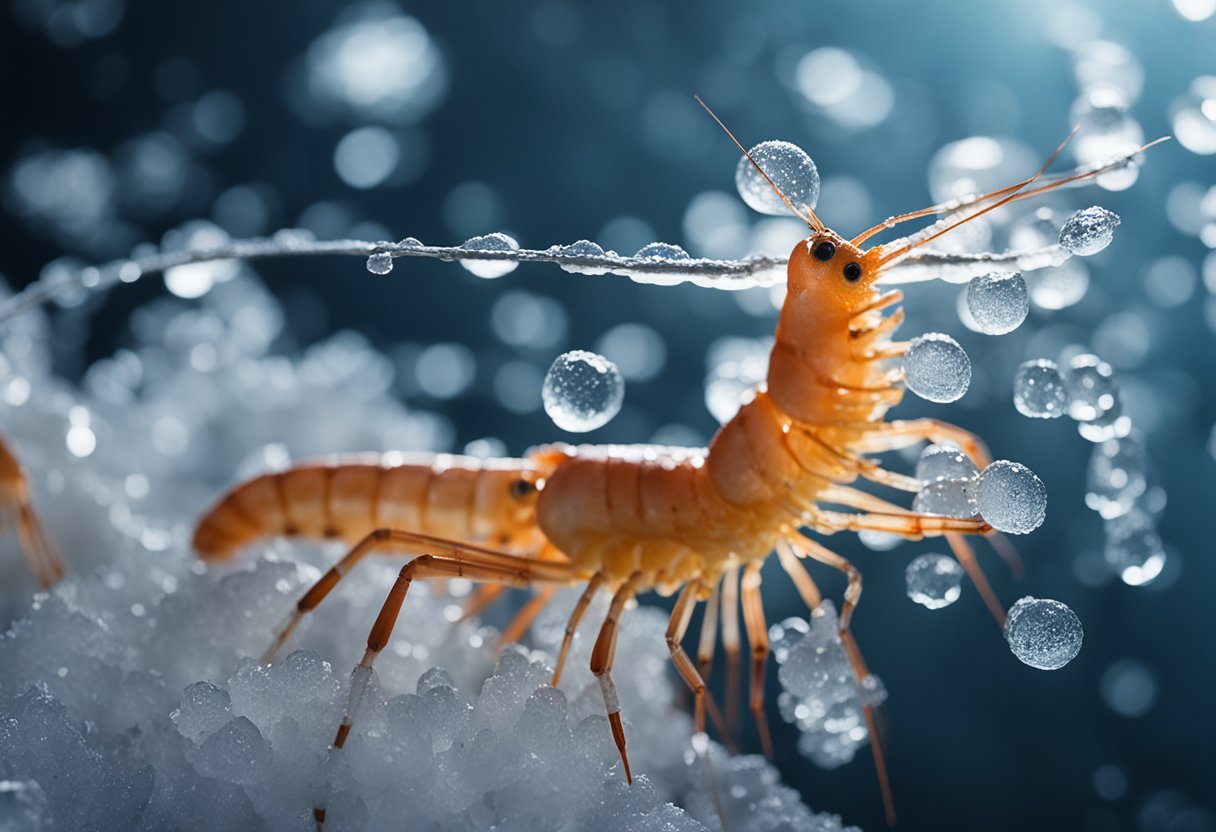
When it comes to cooked shrimp, it’s important to know how to properly freeze and thaw them to ensure they stay fresh and safe to eat.
Here’s what I’ve learned about the freezing and thawing process for shrimp:
Freezing Cooked Shrimp
If you have leftover cooked shrimp that you want to freeze, it’s important to do so as soon as possible after cooking to prevent bacteria growth.
Here are the steps to follow:
- Let the shrimp cool down to room temperature.
- Place the shrimp in an airtight container or freezer bag, making sure to remove as much air as possible to prevent freezer burn.
- Label the container or bag with the date so you can keep track of how long it’s been in the freezer.
- Place the container or bag in the freezer.
Cooked shrimp can be stored in the freezer for up to three months. However, it’s important to note that refreezing shrimp that has already been thawed is not recommended, as it can lead to a loss of quality and increase the risk of foodborne illness.
Thawing Frozen Cooked Shrimp
When it’s time to thaw your frozen cooked shrimp, there are a few different methods you can use:
- Thaw in the refrigerator: This is the safest method, but it can take several hours or even overnight depending on the amount of shrimp you’re thawing.
- Thaw in cold water: Place the frozen shrimp in a sealed plastic bag and submerge it in cold water. Change the water every 30 minutes until the shrimp is thawed.
- Thaw in the microwave: Use the defrost setting on your microwave to thaw the shrimp, being careful not to overcook it.
Once the shrimp is thawed, it’s important to use it within a day or two to ensure it stays fresh and safe to eat. Refreezing thawed shrimp is not recommended, as it can lead to a loss of quality and increase the risk of foodborne illness.
Overall, by following these simple steps for freezing and thawing cooked shrimp, you can ensure that your shrimp stays fresh and delicious for as long as possible.
Identifying Spoiled Shrimp
As a cook, it is crucial to know how to identify spoiled shrimp. Eating spoiled shrimp can lead to food poisoning, which can cause severe symptoms such as nausea, vomiting, and diarrhea. It is essential to know the indicators of spoiled shrimp to avoid consuming them.
One of the first signs of spoiled shrimp is a slimy texture. Fresh shrimp should have a firm, slightly translucent appearance.
If you notice a slimy texture, it may be a sign that the shrimp is old and has started to spoil. Another indicator of spoiled shrimp is bacterial growth, which can cause the shrimp to have a foul odor.
Spoiled shrimp may also have blue spots or white flecks on their shells or flesh. These spots are caused by mold growth, which can occur when the shrimp is not stored correctly.
Mold growth can also lead to a squishy texture in the shrimp, which is another sign of spoilage.
It is essential to note that shrimp can spoil quickly, especially if they are not stored at the right temperature. Cooked shrimp should not be kept at temperatures over 40 degrees F for more than two hours at the most.
If temperatures are higher than 90 degrees F, you only have around an hour to use cooked shrimp before it is no longer safe to eat.
In summary, identifying spoiled shrimp is crucial to avoid food poisoning. Indicators of spoiled shrimp include a slimy texture, foul odor, blue spots or white flecks, and a squishy texture.
Shrimp can spoil quickly, so it is essential to store them at the right temperature and use them within the recommended time frame.
Health Risks Associated with Consuming Spoiled Shrimp
As with any perishable food item, consuming spoiled shrimp can lead to a range of health risks. Bacteria can grow quickly on shrimp, especially if it is not stored properly.
When shrimp is left out at room temperature for too long, bacteria can multiply rapidly, leading to foodborne illness.
Symptoms of food poisoning from consuming spoiled shrimp can include nausea, vomiting, and diarrhea. In some cases, it can even lead to a bacterial infection such as salmonella.
Those who are immunocompromised or pregnant may be at a higher risk of developing severe symptoms from consuming spoiled shrimp.
It is important to note that the symptoms of food poisoning from consuming spoiled shrimp may not appear immediately. It can take several hours or even days for symptoms to develop.
Therefore, it is crucial to properly store and handle shrimp to prevent spoilage and the growth of harmful bacteria.
If you suspect that you have consumed spoiled shrimp and are experiencing symptoms of food poisoning, it is essential to seek medical attention immediately. Treatment may include rehydration and medication to alleviate symptoms.
In summary, consuming spoiled shrimp can lead to foodborne illness and a range of health risks. Proper storage and handling of shrimp is crucial to prevent spoilage and the growth of harmful bacteria.
If you suspect that you have consumed spoiled shrimp and are experiencing symptoms of food poisoning, seek medical attention immediately.
Reheating Shrimp: Best Practices and Precautions

When it comes to reheating shrimp, there are a few best practices and precautions to keep in mind to ensure the best texture and flavor.
Firstly, it’s important to note that reheated shrimp may not have the same texture as freshly cooked shrimp. If reheated improperly, shrimp can become rubbery or slimy. Therefore, it’s important to reheat shrimp gently and avoid overcooking.
One of the best ways to reheat shrimp is on the stovetop. Simply place the shrimp in a skillet or frying pan over medium heat and cook until heated through. You can also add a little bit of oil or butter to the pan to help prevent the shrimp from sticking.
Another option is to reheat shrimp in the oven. Place the shrimp in a baking dish and cover with foil. Heat in a preheated oven at 350°F for 10-15 minutes, or until heated through.
It’s important to note that shrimp should be reheated to an internal temperature of at least 165°F to ensure that it’s safe to eat. Use a food thermometer to check the temperature of the shrimp before serving.
When reheating shrimp, it’s also important to pay attention to its texture. If the shrimp becomes rubbery or slimy, it may be a sign that it has been reheated for too long or at too high of a temperature. If this happens, discard the shrimp and do not eat it.
In summary, reheating shrimp can be done safely and effectively if done correctly. By following these best practices and precautions, you can enjoy delicious reheated shrimp without sacrificing texture or flavor.
Guidelines for Leftover Shrimp
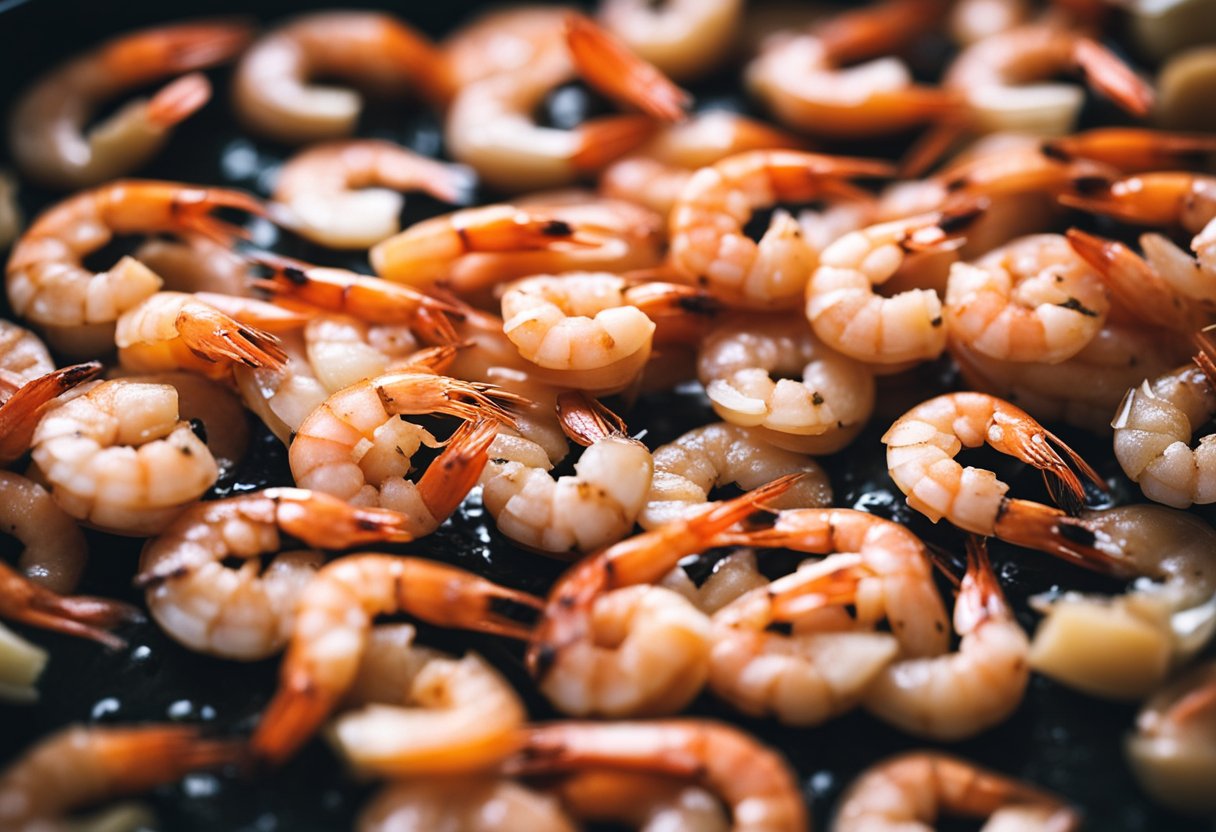
As a professional cook, I know that leftover shrimp can be a delicious and convenient addition to any meal.
However, it’s important to follow some guidelines to ensure that the shrimp is safe to eat and doesn’t go to waste.
First of all, it’s important to refrigerate leftover shrimp as soon as possible. Cooked shrimp should not be kept at temperatures over 40 degrees F for more than two hours at the most.
If temperatures are higher than 90 degrees F, you only have around an hour to use cooked shrimp before it is no longer safe to eat. Therefore, if you have leftover shrimp, you should put it in the fridge within two hours of cooking it.
When it comes to storing leftover shrimp, you should make sure that it is in an airtight container. This will help to prevent bacteria from growing on the shrimp and keep it fresh for longer.
You can store leftover shrimp in the fridge for up to four days. If you’re not going to eat it within that time, you should discard it.
If you’re planning to eat leftover shrimp, you should reheat it thoroughly before eating it. When reheating leftover shrimp, it’s best to use a low temperature to avoid the rubbery texture shrimp can get when overcooked.
You can reheat leftover shrimp in the microwave, on the stovetop, or in the oven. Just make sure that it reaches a temperature of at least 165 degrees F before you eat it.
In conclusion, leftover shrimp can be a tasty and convenient addition to any meal, but it’s important to follow some guidelines to ensure that it’s safe to eat.
Remember to refrigerate leftover shrimp as soon as possible, store it in an airtight container, and reheat it thoroughly before eating it. If you’re not going to eat leftover shrimp within four days, it’s best to discard it to avoid any potential health risks.
Cross-Contamination: A Hidden Risk
As someone who has worked in the food industry for years, I know firsthand the importance of preventing cross-contamination.
Cross-contamination occurs when harmful bacteria from one food item is transferred to another food item, putting consumers at risk for foodborne illness. This is especially important when it comes to cooked shrimp that has been left out at room temperature.
According to the USDA, cooked shrimp should be refrigerated within 2 hours of cooking to prevent bacterial growth. If shrimp has been left out for more than 2 hours, it should be discarded.
This is because bacteria can multiply rapidly in the “danger zone” between 40°F and 140°F.
To prevent cross-contamination, it’s important to store cooked shrimp in an airtight container in the fridge. This will prevent any bacteria from spreading to other foods.
It’s also important to use separate cutting boards, utensils, and dishes when preparing and serving shrimp to prevent cross-contamination.
In addition, it’s important to wash your hands thoroughly with soap and warm water before and after handling shrimp. This will help prevent the spread of bacteria from your hands to the shrimp or other foods.
In conclusion, preventing cross-contamination is crucial when it comes to food safety. By following proper food handling practices and refrigerating cooked shrimp within 2 hours, you can reduce the risk of foodborne illness.
Special Cases: Buffets and Shrimp Dishes
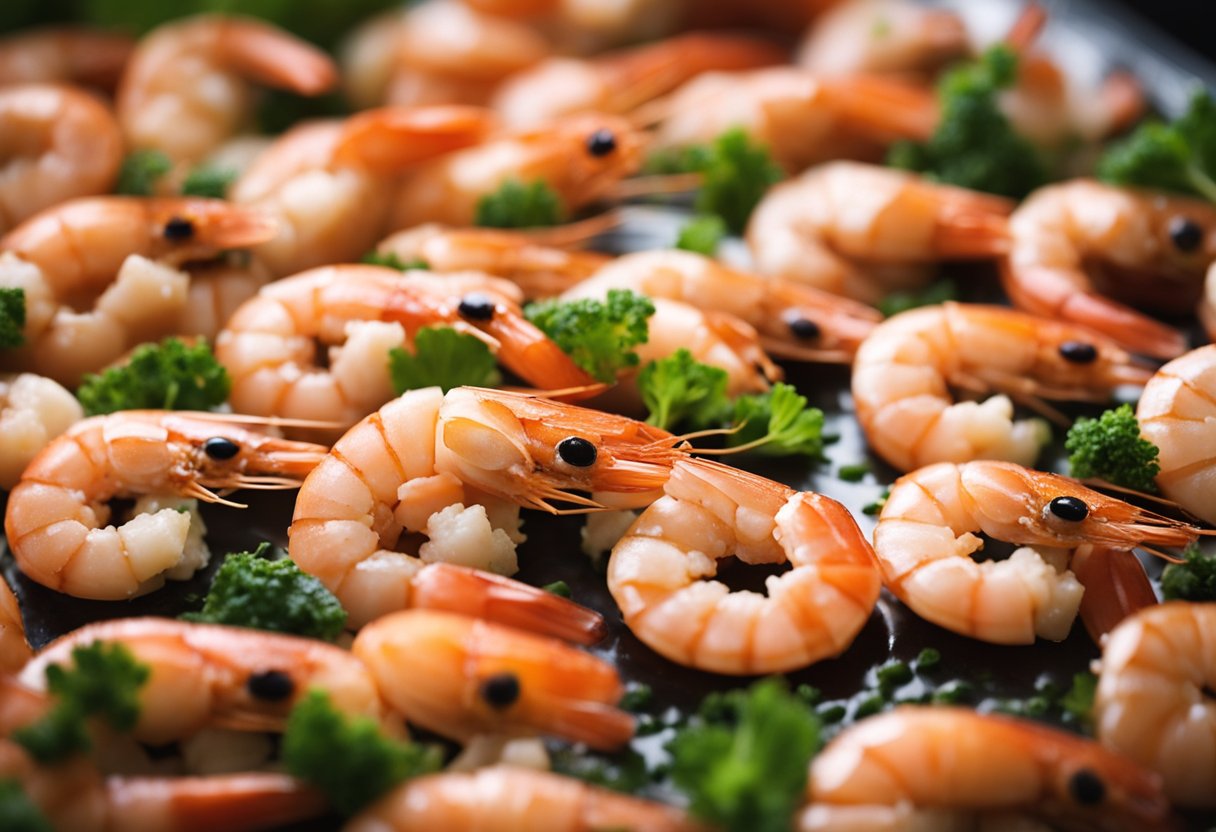
When it comes to serving cooked shrimp at a buffet or in a shrimp dish, there are some special considerations to keep in mind.
The following tips will help to ensure that your shrimp stays safe and delicious for your guests.
- Keep shrimp dishes chilled: If you are serving shrimp as part of a dish, such as in a Thai pawn shrimp salad or shrimp cocktail, make sure that the dish is kept chilled at all times. You can use ice or a cold pack to keep the dish at a safe temperature.
- Monitor the temperature: If you are serving shrimp at a buffet, it is important to monitor the temperature of the shrimp to ensure that it stays within a safe range. You can use a thermometer to check the temperature of the shrimp periodically.
- Discard old shrimp: If shrimp has been sitting out at room temperature for more than two hours, it is no longer safe to eat and should be discarded. This is especially important for shrimp that has been sitting out at a buffet.
- Use a clean serving utensil: When serving shrimp at a buffet, it is important to use a clean serving utensil for each new batch of shrimp. This will help to prevent cross-contamination and ensure that the shrimp stays safe to eat.
- Label shrimp dishes: If you are serving multiple dishes at a buffet, make sure to label each dish with the type of shrimp and the date and time that it was prepared. This will help to ensure that guests are aware of what they are eating and how long it has been sitting out.
By following these tips, you can ensure that your cooked shrimp stays safe and delicious, whether you are serving it at a buffet or as part of a shrimp dish.
Understanding the Shelf Life of Shrimp
As a chef, I know that food safety is of utmost importance. One of the most common questions I get asked is how long can cooked shrimp stay out. The answer is that it depends on various factors, such as the temperature, packaging, and shelf life.
When it comes to shelf life, cooked shrimp can typically last for 3 to 4 days in the refrigerator, according to Revitalio.
However, this can vary depending on the packaging. If the cooked shrimp is stored in an airtight container, it can last longer than if it’s stored in an open container.
Another important factor to consider is the temperature. The FDA recommends refrigerating cooked shrimp within 2 hours, with a maximum storage duration of 3 to 4 days.
If the temperature is higher than 90 degrees F, you only have around an hour to use cooked shrimp before it is no longer safe to eat, according to PreparedCooks.com.
It’s also important to note that cooked shrimp should not be kept at temperatures over 40 degrees F for more than two hours at the most, as mentioned by PreparedCooks.com.
When storing cooked shrimp, make sure to put it in the refrigerator no longer than an hour after cooking it. Properly storing cooked shrimp can ensure that it lasts for the estimated time frame which is 3 to 4 days, according to Limitless Cooking.
In summary, the shelf life of cooked shrimp can vary depending on the packaging, temperature, and storage time.
To ensure the safety of your food, make sure to store cooked shrimp in an airtight container, refrigerate it within 2 hours, and keep it at temperatures below 40 degrees F.
Young and Pregnant: Extra Precautions
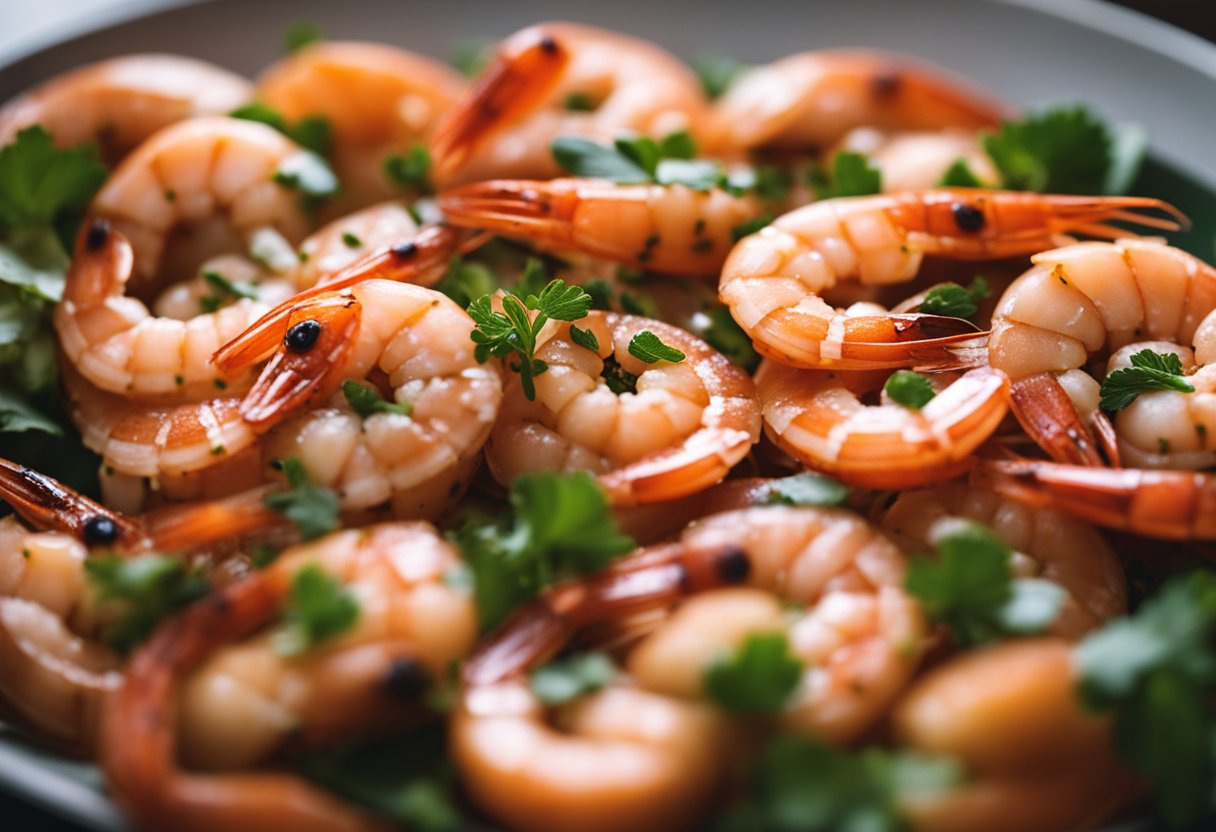
As a pregnant woman, you may be concerned about consuming cooked shrimp that has been left out for too long.
While cooked shrimp is generally safe to eat, extra precautions should be taken during pregnancy to ensure the safety of both you and your baby.
It is recommended that pregnant women limit their consumption of seafood due to the risk of mercury exposure. However, cooked shrimp is considered safe for pregnant women to eat in moderation as long as it has been properly stored and cooked.
When it comes to cooked shrimp that has been left out, the same rules apply for pregnant women as for everyone else. Cooked shrimp should not be kept at temperatures over 40 degrees F for more than two hours at the most.
If temperatures are higher than 90 degrees F, you only have around an hour to use cooked shrimp before it is no longer safe to eat.
To ensure the safety of your unborn child, it is important to follow these guidelines and properly store and cook your shrimp. If you are unsure about the safety of your shrimp, it is best to err on the side of caution and avoid consuming it.
In addition to following proper food safety guidelines, pregnant women should also be aware of the potential health benefits of consuming cooked shrimp.
Shrimp is a good source of protein and contains important nutrients such as omega-3 fatty acids, which are essential for fetal development.
In conclusion, while cooked shrimp is generally safe for pregnant women to eat, extra precautions should be taken to ensure its safety.
By following proper food safety guidelines and consuming shrimp in moderation, you can enjoy the health benefits of this delicious seafood while protecting the health of your unborn child.
Related posts:
Frequently Asked Questions
Can cooked shrimp be left out overnight?
No, cooked shrimp should not be left out overnight. According to PreparedCooks.com, cooked shrimp should not be kept at temperatures over 40 degrees F for more than two hours at the most.
If temperatures are higher than 90 degrees F, you only have around an hour to use cooked shrimp before it is no longer safe to eat. Leaving cooked shrimp out overnight can increase the risk of foodborne illness.
How long can cooked shrimp stay at room temperature?
Cooked shrimp can stay at room temperature for up to two hours before it needs to be refrigerated. However, if the temperature is above 90 degrees F, cooked shrimp should not be left out for more than an hour.
What is the maximum time cooked shrimp can be left unrefrigerated?
The maximum time that cooked shrimp can be left unrefrigerated is two hours. After that, it should be refrigerated to prevent bacterial growth.
How long is it safe to leave cooked shrimp out?
It is safe to leave cooked shrimp out for up to two hours. However, if the temperature is above 90 degrees F, cooked shrimp should not be left out for more than an hour.
Is it safe to eat cooked shrimp that has been left out?
No, it is not safe to eat cooked shrimp that has been left out for more than two hours. Bacteria can grow rapidly at room temperature, increasing the risk of foodborne illness.
How long can cooked shrimp sit out before it goes bad?
Cooked shrimp can sit out for up to two hours before it goes bad. After that, it should be refrigerated to prevent bacterial growth.






